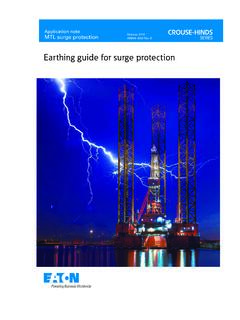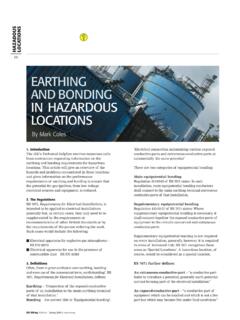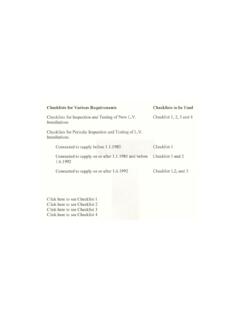Transcription of Guidelines for Telecommunications Structures
1 Guidelines for Telecommunications Structures March 2015 Document Reference: 2-4-5-032 Related Policies and Documents Report Reference Number Issuer Reference Document Name [1] SAI Global AS/NZS Structural Design Actions, Part 0, General Principles [2] SAI Global AS/NZS Structural Design Actions, Part 1, Permanent, Imposed and Other Actions [3] SAI Global AS/NZS Structural Design Actions, Part 2, Wind Actions [4] SAI Global AS/NZS Structural Design Actions, Part 3, Snow and Ice Actions [5] SAI Global AS Structural Design Actions, Part 4, Earthquake Actions [6] SAI Global AS 1657 Fixed platforms, walkways, stairways and ladders design, construction and installation [7] SAI Global AS 2312 Guide to the protection of structural steel against atmospheric corrosion by use of protective coatings [8] SAI Global AS 3600 Concrete Structures [9] SAI Global AS 3995 Design of Steel Lattice Towers and Masts [10]
2 SAI Global AS 4100 Steel Structures [11] SAI Global AS/NZS 4676 Structural Design Requirements for Utility Service Poles [12] NSW Rural Fire Service NSW Rural Fire Service Guidelines for Asset Protection Zones [13] NSW Rural Fire Service NSW Rural Fire Service Practice Note 1/11 - Telecommunications Towers in Bushfire Prone Areas [14] NSW Telco Authority NSW TA Guideline 5 Structural Assessment Guideline for Towers, Masts and Antenna Mounts [15] NSW Telco Authority NSW TA Guideline 6 Radio Site Electricals 2-4-5-032 2-4-5-032 Guidelines For Telecommunications Structures 1 Contents 1. Executive summary .. 4 2. Introduction .. 4 3. Design of Telecommunications Structures .. 6 4. Performance requirements .. 13 5. Documentation requirements .. 19 6. Primary structural support access provisions .. 20 7. lightning protection earthing .. 21 8.
3 Aircraft obstacle 23 9. Corrosion protection of the primary and secondary structural support .. 24 10. Operation and maintenance .. 25 11. Disposal .. 25 12. Terms and Definitions .. 27 2-4-5-032 2-4-5-032 Guidelines For Telecommunications Structures 2 Table of Tables Table 1: Classification of service .. 6 Table 2: Structure importance level per service classification .. 7 Table 3: Event probability of exceedance per service classification .. 7 Table 4: Site fill materials .. 18 Table 5: Documentation formats .. 19 Table 6: Resistance to earth objectives .. 22 Table 7: Terms and definitions .. 27 2-4-5-032 2-4-5-032 Guidelines For Telecommunications Structures 3 1. Executive summary This standard is intended to provide performance specifications for the selection and design of appropriate radio equipment support Structures for the NSW Government communications infrastructure.
4 This document allows the NSW Government to ensure that the design and supply of Structures on their sites will be of a standard that will ensure compliance with all relevant Australian Standards and reflect industry best practice. This performance standard will seek to encompass as many cases as possible and, as such, will include lattice towers, monopoles, and guyed masts. For each of these cases, specifications will be provided for support structure fo otings, imposed actions, performance requirements, and lightning earthing requirements (note that this is for lightning suppression for the tower only as full site earthing would constitute a separate standard). These specifications will also relate to the site importance level as defined by the client, site designer and/or Customer. 2. Introduction Purpose The purpose of this specification is to provide the designer, supplier and the civil contractor (collectively referred to as the Service Provider) with detailed technical requirements which must be complied with in performing works for the NSW Government.
5 This performance specification is applicable for new primary and secondary support Structures for Telecommunications equipment and defines the whole-of-life requirements including planning, design, performance and construction requirements, operations and maintenance, and disposal. Due consideration shall be given to the durability, serviceability, strength, and quality of the Structures to produce a finished product that is fit for its intended purpose. Variance from this standard is considered acceptable where the alternative solution meets the objectives of the supported services and facilities in a more cost effective manner, taking total cost of ownership in to account. For convenience, the term Primary Support Structure (PSS) is used in a generic sense to include lattice towers, guyed masts, monopoles, head frames and their footings.
6 For convenience the term Secondary Support Structure (SSS) is used in a generic sense to include structural supports for Telco equipment such as antennas, aerials, microwave dishes, RRUs, splitters, converters, and feeder cables mounted on the PSS. Scope The requirements specified in this document apply to all new support Structures designed and constructed for the NSW Government. This document must be used in conjunction with normal practice in the Telecommunications industry. 2-4-5-032 2-4-5-032 Guidelines For Telecommunications Structures 4 In the event that a conflict arises between the requirements of this document and relevant Australian Standard, the mandatory obligations of the Australian Standards shall prevail as follows: Commonwealth and State Acts Australian Standards, Codes and Regulations and BCA NSW Government standards Industry standards It shall be the Service Providers responsibility to use appropriate standards and codes and to follow normally accepted practice in the industry where any areas are not covered by this document.
7 Documentation The PSS and SSS service provider shall submit all technical documentation and drawings to the Customer including revisions. The design documentation shall include all designs, assumptions, reports, method statements, dimensions, member sizes, calculations, and construction drawings in AutoCAD compatible format for the PSS and footing and the SSS. All assumptions must be clarified prior to commencement of works. Certification The Service Provider shall submit engineering certification signed by a Chartered Professional Engineer registered on the National Professional Engineers Register having adequate experience in the given area of practice. The certification shall include any assumptions and exclusions considered in the design and an executive summary of the results. Safety in design The design process represents the conceptualisation of ideas and implementation of strategies, by a professional design team that enable minimising hazards at source.
8 Safety in design is the recognition that a design decision can lead to hazards being built into a product, building, or structure that may manifest itself during construction, operation, maintenance, disposal or demolition. The design team and Service Provider are bound by WHS legislation to record and demonstrate that hazards are eliminated or risk-mitigated for all designs. It should be noted that the Commonwealth WHS Regulations 2011, Chapter 6, Regulation 291 identifies construction work in this field is a high risk activity. Safety in design endeavours to identify, replace, substitute, or mitigate future WHS risks and hence provide a safer workplace environment for those personnel who will construct, manage, operate, work in, maintain, and ultimately demolish the product, structure, or building. 2-4-5-032 2-4-5-032 Guidelines For Telecommunications Structures 5 3.
9 Design of Telecommunications Structures General The PSS and SSS design shall be governed by the current editions of relevant Australian Standards. The design shall comply with all aspects of this specification and any additional requirements shall be stated on the design drawings. The design team and the Service Provider shall take into consideration the aesthetic aspects of the design and ensure that the tower configuration and the configuration of all of its components address, as far as reasonable, any visual concerns. Refer to NSW Telco Authority Guideline 5 (Guideline 5) for a comprehensive guideline on structure design. The following sections provide supporting information and clarification to Guideline 5. Classification of services NSW Government operates services with varying levels of importance. For the purpose of this specification, the following service classifications shall be considered: Service classification Description Mission critical Application is critical to emergency response and management.
10 Unavailability of this application may impact on management of a life and death situation. Operational Application is critical to performing daily operational tasks; however unavailability will not impact on the ability to manage a life and death situation. Business Application is related to business or administrative activities. Information Application provides information that might be useful to a mobile unit, but is not critical to performing their daily tasks. Table 1: Classification of service Criticality of infrastructure Importance or criticality is typically related to the consequence of failure or degradation of the infrastructure element under consideration. For the purpose of this document, the classification for criticality or importance of an infrastructure element is taken to be that of the highest importance level of all services supported.





